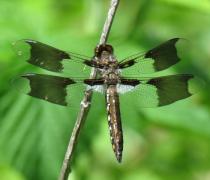This is the most common dragonfly in the yard. They are easy to photograph, since they perchers, who spend most of the time perched in a prominent location, hunting for small insects in the vicinity.
The sexes are dimorphic, and immature males lack the white pruinescence on the abdomen, which they use to flash at other males as they defend their territory along the shore of a pond, marsh, or slow-moving stream. There is also a difference in the end of the abdomens: the males are pointed and the females are stubby.
Dragonflies spend most of their lives underwater as nymphs, feeding on aquatic invertebrates. When they emerge as adults in the spring or summer, they live only a few weeks. During that time they mate and the females deposit eggs in a suitable aquatic location. So what are these dragonflies doing in my yard? Why are the Common Whitetails so common?
There are a few small streams and ponds within a few blocks of our house. Perhaps they come to the yard to hunt insects, then return to the water to reproduce. I guess I need to go on a field trip to find the source of that water. Maybe I'll find the water source and see the males defend their territories while the females deposit their eggs. If so, I'll post something here about it.
 |
 |
 |
| Immature male |
Adult male |
Adult female |
- Links
- Wikipedia
- Mike Powell: Male and female Common Whitetail dragonflies
- 10,000 THINGS OF THE PACIFIC NORTHWEST: Plathemis lydia (Common Whitetail)
Plathemis lydia
(Common Whitetail)
On raspberry stalk
Adult female
Associated Species: Rubus idaeus (Red Raspberry)
Plathemis lydia
(Common Whitetail)
Immature male
Plathemis lydia
(Common Whitetail)
Adult female
Plathemis lydia
(Common Whitetail)
Adult male
Plathemis lydia
(Common Whitetail)
Adult female
Plathemis lydia
(Common Whitetail)
Immature male
Plathemis lydia
(Common Whitetail)
Adult female
Plathemis lydia
(Common Whitetail)
Adult male
Plathemis lydia
(Common Whitetail)
Adult female
Plathemis lydia
(Common Whitetail)
Immature male
Plathemis lydia
(Common Whitetail)
Immature male
Plathemis lydia
(Common Whitetail)
Adult female
Plathemis lydia
(Common Whitetail)
Adult female
Plathemis lydia
(Common Whitetail)
Adult female
Plathemis lydia
(Common Whitetail)
Immature male
s_idstdClass Object
(
[id] => 222
[genus_id] => 286
[species_name] => lydia
[common_name] => Common Whitetail
[species_text] =>
This is the most common dragonfly in the yard. They are easy to photograph, since they perchers, who spend most of the time perched in a prominent location, hunting for small insects in the vicinity.
The sexes are dimorphic, and immature males lack the white pruinescence on the abdomen, which they use to flash at other males as they defend their territory along the shore of a pond, marsh, or slow-moving stream. There is also a difference in the end of the abdomens: the males are pointed and the females are stubby.
Dragonflies spend most of their lives underwater as nymphs, feeding on aquatic invertebrates. When they emerge as adults in the spring or summer, they live only a few weeks. During that time they mate and the females deposit eggs in a suitable aquatic location. So what are these dragonflies doing in my yard? Why are the Common Whitetails so common?
There are a few small streams and ponds within a few blocks of our house. Perhaps they come to the yard to hunt insects, then return to the water to reproduce. I guess I need to go on a field trip to find the source of that water. Maybe I'll find the water source and see the males defend their territories while the females deposit their eggs. If so, I'll post something here about it.
 |
 |
 |
| Immature male |
Adult male |
Adult female |
- Links
- Wikipedia
- Mike Powell: Male and female Common Whitetail dragonflies
- 10,000 THINGS OF THE PACIFIC NORTHWEST: Plathemis lydia (Common Whitetail)
[cultivated] => 0
[introduced] => 0
)
stdClass Object
(
[id] => 377
[k_id] => 1
[p_id] => 2
[sp_id] => 1
[c_id] => 7
[sc_id] => 1
[o_id] => 13
[so_id] => 10
[io_id] => 0
[supf_id] => 74
[f_id] => 132
[sf_id] => 0
[t_id] => 0
[st_id] => 0
[g_id] => 286
[sg_id] => 0
[s_id] => 222
[ss_id] => 0
[o_desc] => Adult female
[o_time] => 1527458400
[inat_time] => 1527458400
[cat_id] => 120
[o_image] =>
[o_featured] => 0
[inat_url] => https://www.inaturalist.org/observations/12896258
[inat_image_url] => https://inaturalist-open-data.s3.amazonaws.com/photos/18726705/large.jpeg
[o_short_desc] =>
[lowest_level] => s_id
[llid] => 1
[cultivated] => 0
[introduced] => 0
[good_image] => 1
[pollinating] => 0
[pollinating_level] =>
[eco_interaction] => 0
[gender] =>
[research_grade] => 0
[beeatlas] =>
[admin_notes] =>
)

Plathemis lydia
(Common Whitetail)















